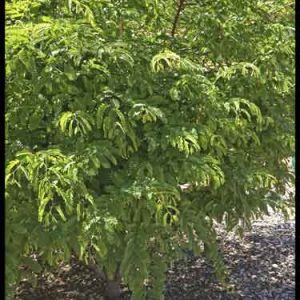Tamarindus indica
Tamarind
Origin
Tamarind originated in Central East Africa but has been grown in India for so long that many believed it came from there. It is now found throughout much of the tropics. The name ‘tamarind’ is derived from Arabic: ‘tamar’ = ‘date’ and ‘hind’ is the name for ‘India’.
Climate
It is a versatile tree, growing in many sub-tropical and semi-arid tropical areas. It grows well in temperatures of 10-37°C and mature trees can withstand extremes of -3-47°C. Optimal annual rainfall is 500-1500mm, but with good drainage it can withstand much more, even though under such conditions it may not flower. A long dry period each year is necessary for fruit development.
Plant Description
It is a large leguminous sub-tropical deciduous tree which can grow to more than 25m in its native habitat, often multistemmed and with a broad canopy. The compound paripinnate leaves have 5-20 pairs of leaflets which fold shut at night and when under stress conditions.
Relatives
A member of the Fabaceae (formerly Leguminosae) Family. Relatives include carob, ice cream bean and African locust bean.
Soils
Not demanding of soil types, but better yields are obtained when they are deep and well-drained, as it is intolerant of water logging.
Propagation
It has been traditionally grown from seeds which have been scarified or soaked in water to increase germination. However cuttings and grafting offer real advantages when taken from superior trees.
Cultivars
The two major types of tamarind are the sweet and sour types, with the former having red pulp colouration and the latter brown. However most trees are unselected seedlings with variable qualities. Many countries in South East Asia have developed better varieties, but these can be difficult to source in WA.
Flowering and Pollination
The inflorescence racemes are small and drooping with each flower having white or cream petals flecked with pink and about 2cm in diameter. The bi-sexual flowers exhibit protogynous dichogamy, with flowering normally occurring in spring or summer. Some fruit will be set with self-pollination, however cross pollination is much more effective.
Pollination is by honeybees attracted to the nectiferous flowers.
Cultivation
Apart from training to produce an appropriate framework of 3-4 main branches when young, it needs little attention.
Wind Tolerance
With its deep taproot and strong trunk and branches it withstands strong winds and even hurricanes very well.
Pruning
Normal removal of dead or crossing branches should be undertaken and size containment may need attention.
The Fruit
The fruit is a pendulous light grey-brown indehiscent pod when ripe, 5-12cm long, either curved or straight with restrictions between the seeds. The brittle shell contains a dark, thick sweet/sour pulp surrounding 1-10 reddish-brown seeds.
Fruit Production and Harvesting
Juvenility may last for 7-12 years in seedlings and half this with vegetatively propagated plants. Fruit take 8-12 months to mature. They are harvested when moisture content has decreased to about 20%, as indicated by a hollow sound when tapped. Fruit maturity on an individual tree is staggered, which is a plus for home gardeners but not in commercial operations. If left unharvested, they may remain on the tree for an extended period, even through to next season’s flowering. Well-managed mature trees can produce over 100kg of fruit each year.
Fruit Uses
Tamarind is eaten fresh or used in sauces, syrups, drinks and many cooked and processsed foods. Mature fruits are good sources of calcium and vitamin C, and contain 40-70% carbohydrate plus the highest level of tartaric acid of any fruit.
Pests and Diseases
None known. Possibly carob pod borers might be a problem.
Comments
It is a handsome tree requiring little care that can produce a prodigious crop. Reassuringly for those with restricted space, it usually only grows to a fraction of its normal size outside its native habitat.
